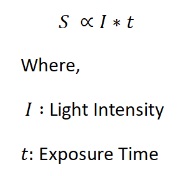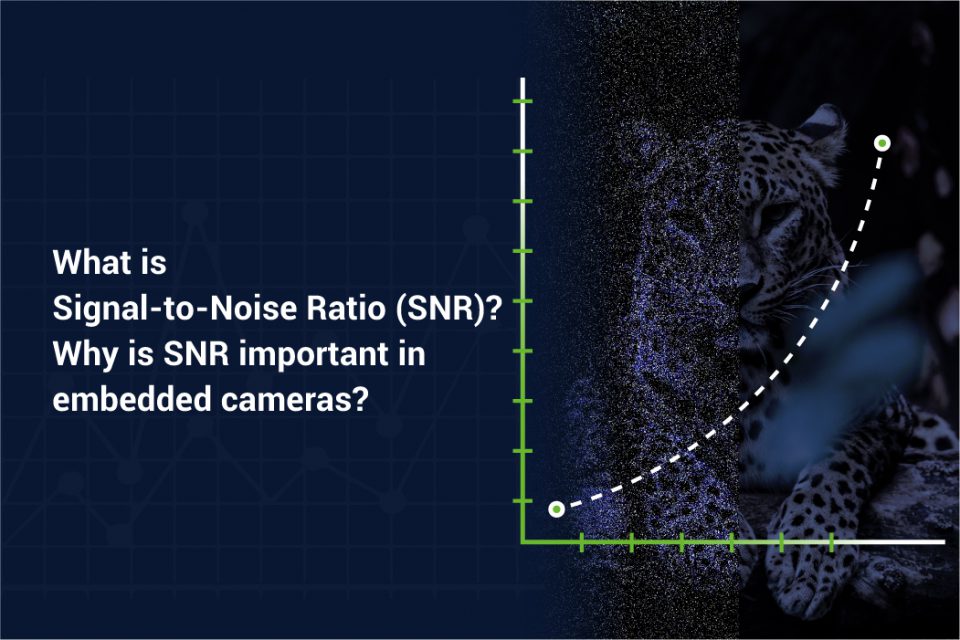Signal-to-Noise Ratio (SNR) probably is not as much of a discussion point today as it was 20 years ago. What was once seen as a daunting task, achieving high SNR has become a standard rather than a special feature in many applications today, especially in camera and imaging-based devices.
However, the term remains a mystery to many. Though many have heard about it, not a lot of us understand what it means, how it is measured, or why it is important in cameras and embedded vision applications.
In this blog, we demystify the concept of Signal-to-Noise Ratio, how it is calculated, and its importance in new-age embedded vision applications such as smart surveillance cameras, remote patient monitoring systems, autonomous checkout cameras, smart signage cameras, etc.
What is Signal-to-Noise Ratio?
Signal-to-Noise Ratio (SNR) measures the strength of the desired signal relative to the background noise, which is an undesired signal. SNR is imperative to distinguish various output signals to achieve efficient output.
Signal-to-Noise Ratio is typically expressed in terms of decibels. The higher the SNR value, the better the output. The reason is that there’s more useful information (signal) than unwanted data (noise) in a high SNR output. For instance, an SNR of 100dB is better than 70 dB.
How to Calculate Signal-to-Noise Ratio
Calculating SNR can vary depending on the device. However, if the signal values are in the decibel form, then SNR is calculated by subtracting the noise quantity from the desired signal.
So, SNR= S-N, where S is the signal quantity, and N is the noise level.
To illustrate this through an example, imagine that your device is receiving a signal of -50 dBm (decibels per milliwatt), and the noise level is -70 dBm. Then Signal-to-noise ratio can be calculated as:
SNR = -50-(-70) = 20dB
Another method to calculate SNR is by taking the linear ratio between the recorded signal and the total root mean squared noise as shown in the formula below, which is called linear SNR.

Importance of SNR in Embedded Cameras
SNR in cameras indicates the signal quality found in an image. High SNR is required in many embedded vision applications, especially the ones that involve edge-based processing where AI/ML algorithms have to analyze the processed image to make intelligent decisions. This is because the image output in such smart AI cameras needs to provide the necessary details for functions such as people counting (in surveillance systems), demography analysis (in smart signages), crop detection (in agricultural robots, vehicles, and drones), object recognition (in autonomous shopping systems, robots), sample analysis (medical microscopes, diagnostic devices), etc.
High SNR also becomes necessary in low-light camera modules where noise levels can have a far more significant and apparent impact on the image quality compared to cameras operating in normal lighting conditions.
Exploring the Relationship Between SNR and Other Camera Features
SNR is correlated to other camera features such as pixel size, sensor features, lens quality, etc. To achieve the best image quality and an increased SNR, understanding how these camera features are related to each other is important. Let us take a look at how various camera properties impact SNR.
Sensor Size: Larger sensors typically capture more light, resulting in a higher SNR. Bigger sensors also mean larger pixels, which can collect more photons, contributing to a better SNR. In contrast, small pixels might have a higher likelihood of noise, impacting the SNR negatively.
Aperture Size: A wider aperture lets in more light, contributing to a higher SNR. Smaller apertures might require longer exposure times, which can introduce more noise. Read more into the details of how SNR and exposure impact each other in the following section – Understanding How Exposure Time Affects SNR
ISO Sensitivity: Higher ISO settings amplify the signal but also amplify the noise, potentially lowering the SNR. Lower ISO settings generally result in better SNR, but they will require more light for proper exposure.
Image Processing Algorithms: Advanced noise reduction algorithms can enhance the SNR by reducing unwanted noise without compromising the image details.
Shutter Speed: Faster shutter speeds can reduce motion blur but require a wider aperture or higher ISO, influencing the SNR. Slower shutter speeds in low light conditions can contribute to a lower SNR due to increased exposure time. Read more into the details of how SNR and exposure impact each other in the following section – Understanding How Exposure Time Affects SNR
Dynamic Range: A camera with good dynamic range can capture a wide range of tones, contributing to a better SNR in both highlights and shadows. Limited dynamic range could result in loss of details in bright or dark areas.
Understanding How Exposure Time Affects SNR
The fundamentals of the relationship between SNR and exposure time can be understood through photon statistics. That is, the Signal (S) is proportional to the number of photons collected during the exposure time, which is calculated as the product of light intensity (I) and the exposure time (t).

While considering incident photon intensity, photon-shot noise (photon-shot noise is a type of noise inherent in any system where light is counted in discrete units, i.e., photons) also comes into the picture. The signal-to-noise ratio due to photon shot noise (SNR_Shot) is given by,

When the exposure time is longer, the number of photons collected (N) also increases, and consequently, the signal (S) also increases. As a result, the square root of the signal (√S) also increases. This means that, in the context of shot noise, the SNR improves as the square root of the exposure time.
One trade-off in choosing longer exposure time is that it leads to more photons collected and, consequently, better SNR due to shot noise. However, longer exposures also increase the likelihood of introducing electronic noise and may lead to issues like thermal noise. Therefore, an optimal exposure time and camera setup that balances these factors should be chosen for a given scene.
Practical Steps to Improve the Signal-to-Noise Ratio of Your Embedded Vision Device
Sometimes to achieve high SNR, there’s a tendency to maximize the gain to improve signal strength. But this leads to spiking the signal as well as the noise. And you’ll notice that there are no major changes to the SNR value – meaning your imaging output may get better contrast, but it’ll continue to face the same quality issues.
So, while deploying embedded cameras in high SNR applications (like microscopes), certain practical steps need to be followed to ensure better quality output (with less noise). Hence, one needs to build/customize/deploy the camera with the right architectural design and use high-quality sensors. In addition, reducing the sensor’s temperature by properly dissipating heat can also help.
Low-noise cameras come with a low read noise image sensor. But in most cases – you also need to ensure active cooling. It would help manage other noise sources in the image sensor. However, this might add to the overall cost of the solution.
Low Noise Cameras from e-con Systems
e-con Systems, an industry pioneer, has 20+ years of experience in designing, developing, and manufacturing OEM cameras for various industries, including medical and life sciences.
e-con Systems over has built a solid portfolio of low noise cameras over the last two decades that are suitable for various embedded vision applications.
Below is a list of all low noise cameras from e-con Systems:
- Sony® Pregius IMX264 Monochrome/Color USB 3.0 Cameras
- e-CAM521_CUMI568C_MOD – 5MP Sony Pregius S IMX568 Global shutter Camera Module
- See3CAM_CU55 – 5MP low noise USB camera
Hope we were able to explain the concept of Signal-to-noise ratio well in this article. If you have any further queries on the topic, please feel free to leave a comment. We shall get back to you as soon as possible.
If you are looking for help in customizing and integrating low-noise cameras into your products, please write to us at camerasolutions@e-consystems.com.
You could also visit our Camera Selector to get a full view of e-con Systems™’ camera portfolio.

Prabu is the Chief Technology Officer and Head of Camera Products at e-con Systems, and comes with a rich experience of more than 15 years in the embedded vision space. He brings to the table a deep knowledge in USB cameras, embedded vision cameras, vision algorithms and FPGAs. He has built 50+ camera solutions spanning various domains such as medical, industrial, agriculture, retail, biometrics, and more. He also comes with expertise in device driver development and BSP development. Currently, Prabu’s focus is to build smart camera solutions that power new age AI based applications.




